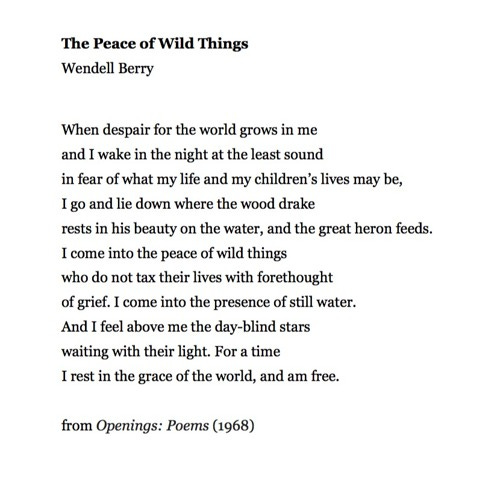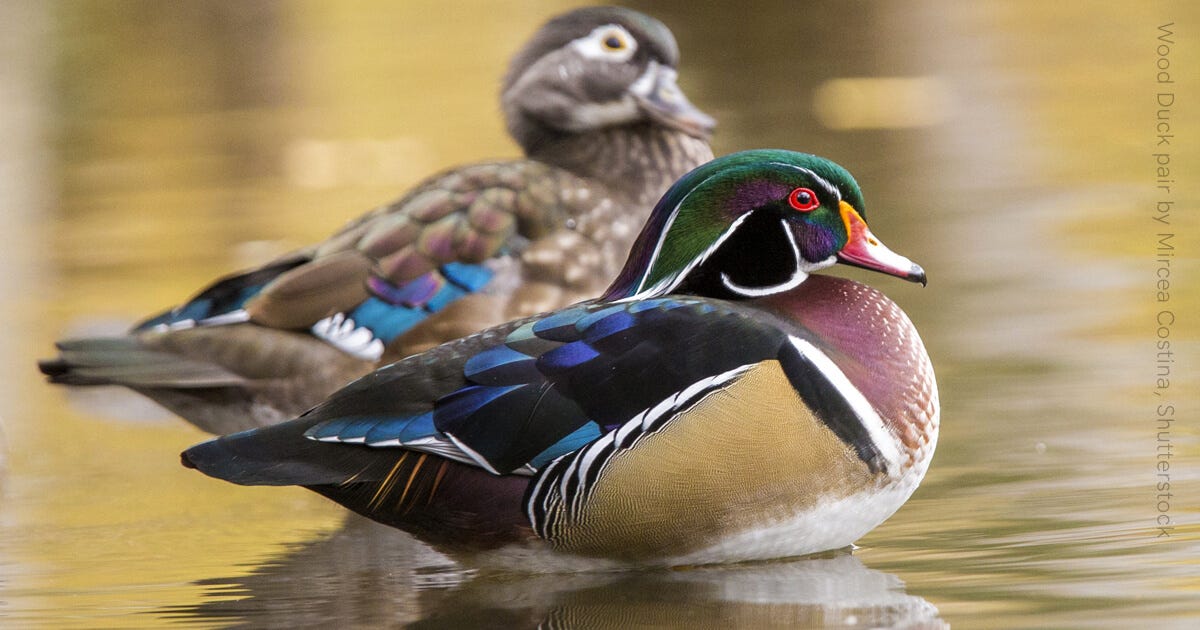"The Peace of Wild Things" by Wendell Berry
Let's gather and talk about poetics and peace (and birds)
Have you met your neighborhood birds? I don’t see many types of birds near my apartment in Boston. We get droves of house sparrows, drab little brown birds that bathe in the dirt and flit above my head, darting from tree to tree. Our apartment is garden-level, and the patio attracts the occasional blue jay or robin that hops around on the bricks, looking for stray orts. I’m thankful to see birds on my day to day. In the city, though, I miss access to more birds–their colors, their songs, their attitudes, and their behaviors.
My parents live in a Boston suburb, so I can visit on occasion for a holiday or long weekend. They have a shaded porch that overlooks a swath of lawn. When I’m there, I take time to sit on the porch to watch the birds. There’s an explosion of diversity: goldfinches, dark-eyed juncos, white-breasted nuthatches, black-capped chickadees, cardinals, robins, and mourning doves. There are woodpeckers (hairy, downy, and red-bellied), starlings and grackles, the occasional Northern flicker; hummingbirds in the summer, turkeys in the fall. My mom saw an oriole slightly adrift on its migration path one spring.
This past week, a friend of mine at school misidentified a robin as a cardinal (or vice versa). The members of our lab chuckled. I was just surprised. The birds are so distinctive. I’d know them by their sound, or their silhouette, or their song. I’ve spent a lot of time watching these birds land on snowy tree branches (cardinal) or scutter across a grassy field listening for worms (robins). I learned all of this from hours spent on my parents’ porch.
At one time, I only cared about the robins or cardinals with their bright colors, and none of the smaller, more neutral birds. And then I watched a fist-sized bird–black on the top and white on the bottom–hop on the mulch. It was inspecting seemingly identical yellow seeds on the ground. Pecking at one, pausing, and pecking at the other. I was curious about this new bird, so I waited and watched the bird break the shells and eat. I asked my mom about the bird, and she told me it was a dark-eyed junco. Now I keep my eye out for them everywhere.
I told my friend about an app you can use to identify birds: Cornell’s Merlin Bird ID. When I want to know the species of a bird, I provide my location then either describe what the bird looks like (with prompts) or record its song. The app then spits out likely bird IDs based on the criteria and the time of year. It is incredible and has introduced me to many new birds. My friend downloaded it.
The next morning, she and a few of our other friends she had told about the app rushed up to me and told me about all of the birds they saw and heard: house finches, mourning doves, robins. They played their songs for me. They talked about taking a break in the afternoon to see what birds were on campus. I told them where I’d seen robins searching for worms in the mornings.
There is a lot to be found in your surroundings when you remember to look.
Today I have “The Peace of Wild Things” by Wendell Berry for you. It is a beautiful piece of work and there is a lot to talk about. I hope that you enjoy it.
Berry opens this poem with despair. He describes this feeling as something alive that can grow inside of you. It may start as something small, easy to ignore. Though as days pass and the despair you feel builds, it can feel like a weight, a balloon, a presence in your chest. It consumes you, and as Berry describes it, even the “least sound” can wake you in the night. This despair is not confined to the body–it emanates out, causing fear “of what my life and my children’s lives may be.”
I’ve felt the despair that Berry describes. It’s overwhelming. When this happens to me, I feel like I am too aware of everything that is going wrong, and how little I can do to fix anything. When this happens to me, it’s hard to get out of bed. It’s hard to move, to eat, to take care of myself. This kind of despair can be paralyzing.
In only three short lines, only 30 words, Berry conveys this strong and specific feeling. He does not say that he is stressed; he writes, “when the despair for the world grows in me.” He does not say that he is paralyzed and can’t sleep; he writes, “I wake in the night at the least sound / in fear.” This is what I love about poetry. Poets take experiences, places, people, and feelings we know and describe them to us anew. Where does Berry go from here? He cracks the poem open. When Berry feels despair:
I go and lie down where the wood drake Rests in his beauty on the water, and the great heron feeds.
Reader, let’s imagine this place. What colors do you imagine? I can see the grass and lush shrubs and trees around a pond. There are patches of damp dirt that you can smell. The pond where the wood drake rests is not blue–it reflects all of the colors around it. There is brown and green, some blue from the sky and patches of white where the sun shines. I can see the wood drake wading, and a green heron standing on a half-submerged branch. The temperature feels just right; there’s a light breeze that rustles leaves overhead.
I come into the peace of wild things Who do not tax their lives with forethought Of grief.
I don’t really know what to tell you about these lines except to tell you that I think they are perfect. I don’t know what to write about the rest of this poem. I can just see and feel what Berry describes to me. I know a wood drake does not think about what tomorrow brings. A heron does not let the world weigh him down. The surface of a pond doesn’t harp on how the coming days will go. I know that In this short poem, Berry understands peace, and reminds the reader of what it feels like. I want to be in the moment that Berry describes. I want to “come in the presence of still water” and I want to “rest in the grace of the world.”
Reader, this poem has settled in me. I think about the wood drake during my day. I stop to watch the robins run across the grass. I am trying to look. Reader, I am sending you this poem to remind you to look and see the world around you.
If you enjoyed this poem… you can read more by Wendell Berry here.
If you are looking for a new read… I have been reading Intermezzo by Sally Rooney and it is phenomenal. I highly recommend it.
If you want to try writing poetry… try writing about the natural world around you—the wild things.









I was going to write something like “thank you for another great read” but that doesn’t feel enough… I carefully read every word and when I finished I read it again to feel it all over again. Thank you for that Katie.